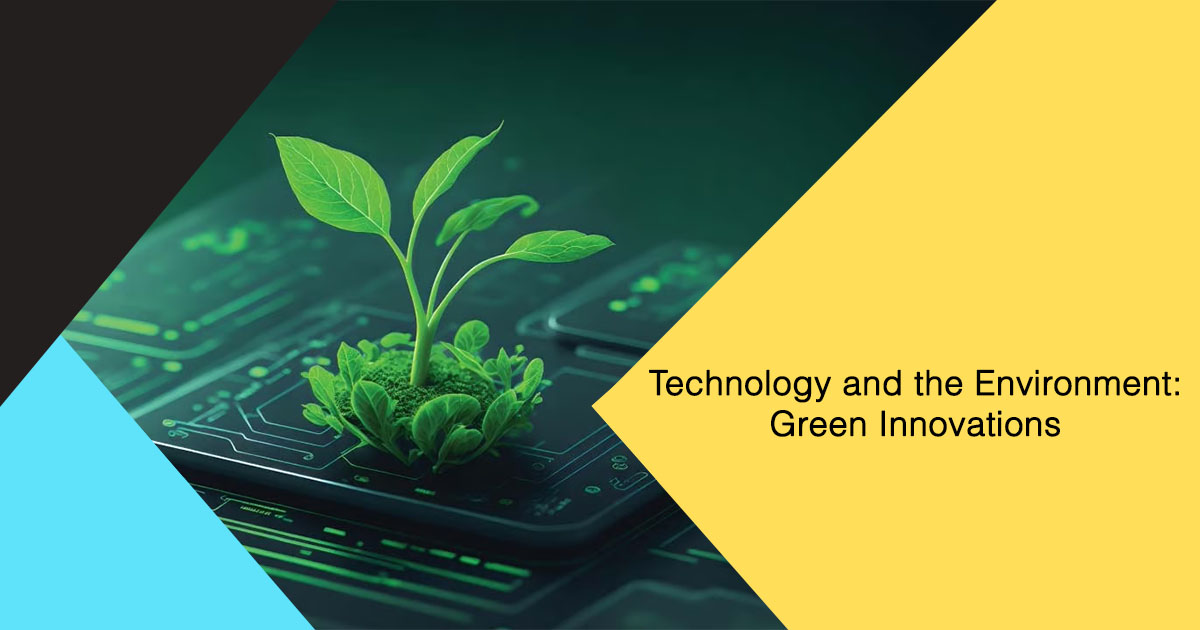Technology and the Environment: Green Innovations in the U.S.

The intersection of technology and environmental sustainability is driving a wave of green innovations across the U.S. These advancements aim to combat climate change, reduce waste, and foster sustainable development. Here’s an overview of key green technologies transforming the U.S. landscape:
1. Renewable Energy Advancements
- Solar Power: U.S. solar capacity has grown significantly, driven by cheaper photovoltaic (PV) panels, residential solar adoption, and community solar farms.
- Innovation: Perovskite solar cells and bifacial panels promise higher efficiency and affordability.
- Wind Energy: Offshore wind projects like Vineyard Wind off the Massachusetts coast are scaling up to meet clean energy targets.
- Technology: Floating wind turbines are enabling projects in deeper waters.
- Hydropower and Geothermal: Modernized hydroelectric plants and enhanced geothermal systems (EGS) are expanding clean energy portfolios.
2. Green Building Technologies
- Net-Zero Buildings: Structures designed to produce as much energy as they consume, using solar panels, advanced insulation, and energy-efficient systems.
- Smart Cities: Urban planning integrates IoT sensors and AI to optimize energy use, reduce emissions, and enhance waste management.
- Example: Smart streetlights in San Diego reduce energy usage by 60% through adaptive lighting.
- Sustainable Materials: Innovations like carbon-capturing concrete, bamboo-based construction, and recycled plastics are replacing traditional building materials.
3. Electric Vehicles and Sustainable Transportation
- EV Growth: The adoption of electric vehicles is reducing reliance on fossil fuels. Investments in nationwide EV charging infrastructure are accelerating this shift.
- Micromobility: E-bikes, e-scooters, and electric public transportation options are providing eco-friendly alternatives for urban commutes.
- Hydrogen Fuel Cells: Clean hydrogen is emerging as a sustainable fuel for trucks, buses, and trains.
- Autonomous and Shared Mobility: AI-driven ride-sharing platforms reduce traffic congestion and emissions by optimizing routes and vehicle usage.
4. Agricultural Innovations
- Precision Farming: AI, drones, and sensors enable farmers to monitor soil health, optimize irrigation, and reduce chemical use, increasing efficiency while minimizing environmental impact.
- Vertical Farming: Indoor farms use hydroponics and LED lighting to grow crops with 90% less water and without pesticides.
- Regenerative Agriculture: Techniques like no-till farming and cover cropping improve soil health, capture carbon, and enhance biodiversity.
5. Circular Economy Solutions
- Waste-to-Energy: Technologies convert waste into usable energy, such as methane gas from landfills and biomass.
- Recycling Innovations: AI-powered sorting systems and chemical recycling processes are improving the efficiency of material recovery and reuse.
- Product Design: Companies are adopting "cradle-to-cradle" principles, creating products designed for recyclability or composting.
6. Carbon Capture and Storage (CCS)
- Direct Air Capture: Facilities like Climeworks in Iceland and emerging U.S. projects are removing CO₂ directly from the atmosphere.
- Carbon Sequestration: Geological storage and reforestation projects help lock away captured carbon.
- Industrial Applications: Captured carbon is used to manufacture materials like fuels, plastics, and concrete.
7. Water Conservation and Purification
- Desalination: Advanced filtration systems and energy-efficient desalination plants are addressing water shortages in arid regions.
- Smart Irrigation: IoT-based systems optimize water use in agriculture, significantly reducing waste.
- Pollution Mitigation: Technologies like floating wetlands and nanotechnology filters are tackling water contamination.
8. Waste Reduction and Management
- Composting Technology: High-tech composting facilities are converting food waste into organic fertilizers at scale.
- Plastic Alternatives: Biodegradable and plant-based materials are replacing single-use plastics.
- E-Waste Recycling: Initiatives like eco-friendly electronics and automated recycling systems aim to address the growing e-waste problem.
9. Green Energy Storage
- Advanced Batteries: Innovations in lithium-ion and solid-state batteries enhance energy storage capacity for renewable energy systems.
- Grid-Scale Storage: Flow batteries and gravity-based systems store excess renewable energy for use during peak demand.
- Hydrogen Storage: Clean hydrogen serves as a versatile energy carrier, balancing intermittent renewable energy production.
10. Biotechnology for Environmental Solutions
- Algae Biofuels: Algae-based biofuels offer a carbon-neutral alternative to traditional fossil fuels.
- Bioplastics: Microbial engineering produces biodegradable plastics that decompose naturally.
- Pollution Cleanup: Genetically engineered microbes are used to clean up oil spills and degrade toxic waste.
11. AI and Big Data for Sustainability
- Climate Modeling: AI-driven models predict climate trends, helping policymakers design effective mitigation strategies.
- Energy Management: Smart grids use AI to balance supply and demand, integrate renewables, and reduce energy waste.
- Resource Optimization: AI helps industries minimize resource consumption and identify inefficiencies.
12. Policy and Collaboration
- Federal Initiatives: Programs like ARPA-E fund high-impact clean energy technologies.
- Public-Private Partnerships: Collaboration between tech companies and governments accelerates green innovation.
- Grassroots Movements: Community-driven projects, such as local renewable energy co-ops, foster bottom-up solutions.
Challenges and Opportunities
- Challenges:
- High initial costs for green technologies.
- Resistance to change from traditional industries.
- Dependence on critical materials like rare earth metals for green tech.
- Opportunities:
- Job creation in renewable energy and green manufacturing.
- Strengthening U.S. leadership in global sustainability efforts.
- Long-term cost savings and environmental benefits.
Conclusion
Green innovations in the U.S. are at the forefront of addressing environmental challenges. From renewable energy and sustainable agriculture to cutting-edge technologies in recycling and carbon capture, these advancements are reshaping industries and driving progress toward a more sustainable future. With continued investment, policy support, and public engagement, the U.S. is well-positioned to lead in the global transition to a greener economy.










